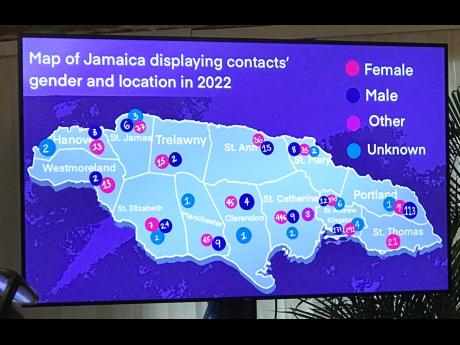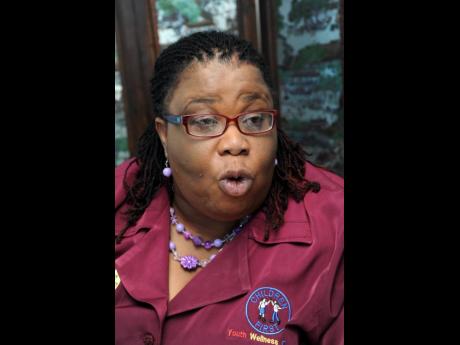Major increase in Portland boys calling SafeSpot for help
Last year, there was a major spike in the number of boys from Portland, who, on a monthly basis, contacted the Office of the Children’s Advocate (OCA) through its SafeSpot helpline, raising a red flag regarding the need for more child-protection services to be offered in that parish.
After a recent review of contacts made to the two-year-old helpline, it was recognised that there was a major increase in boys calling or sending WhatsApp messages for help from Portland in the year 2022. The boys from Portland also topped the ‘concerns about self’ category of callers by gender and parish.
There were 113 males who called for help from Portland, while there were nine females and one unknown gender. This follows St Andrew and Kingston with the highest number of male callers, totalling 370 and 291, respectively.
This raised concerns for not only Children’s Advocate Diahann Gordon Harrison, but other professionals in the child protective services industry as well.
It was Gordon Harrison who revealed the data on the findings from the calls to SafeSpot in 2022 during a media briefing last Wednesday at the Terra Nova All Suite Hotel in St Andrew.
“For ‘concerns about self’ – this has to do with needing external validation, self-esteem issues, self-worth, confidence, and so on – Portland is in the lead, and interestingly, it’s the males who are saying they have concerns about themselves, followed by St Catherine, which doesn’t seem to want to be left out of the statistics at all, with the females coming in very strongly as having concerns about themselves,” Gordon Harrison said.
“Portland is the only parish where we had more boys reaching out than girls. We had 113 boys reaching out from Portland in comparison to only nine girls. That’s an interesting disaggregation. Sometimes we say that children in the urban centres reach out a little bit more, but Portland is showing a little bit of a dissonance we generally anticipate,” she said.
She also noted that youth ages 16 and 17 were most prominent among those who contacted SafeSpot in 2022. The other prominent groups are the 13- to 15-year-old children, followed by the 10- to 12-year-old children. She also expressed concern about the number of boys who reached out from the capital city.
“In Kingston, we had 177 boys, which is very interesting because it shows a spike in the number of boys that are certainly reaching out from Kingston, but of course, not to be outdone, we had 291 girls,” she said.
On the other hand, Gordon Harrison also noted that there were no males from St Catherine who called about “fear and anxiety problems”, but females from St Catherine were disproportionately represented.
Two other startling revelations were that all contactors to SafeSpot from St Thomas were females, totalling 21 girls, and 446 girls from St Catherine reached out through calls, WhatsApp messages, and other online communication for help in 2022, resulting in the parish with the highest number of girls making contact per parish last year and topping the number of callers in the ‘concerns about self’ category.
... Girls from St Catherine lead in contacts made about ‘self-harming’ and ‘mental health’
Claudette Pious, co-founder and executive director of Children First, who was present last week for release of data from the Office of the Children’s Advocate’s SafeSpot helpline, raised concerns about the prominence of girls in St Catherine who have been contacting the OCA for assistance.
“I feel emotional about it, because I work in St Catherine. We have done a lot of referrals to SafeSpot,” Pious said.
Following Pious’ point, Hyacinth Blair, senior director, Children Affairs and Policy Division, Ministry of Health and Wellness, asked for the specific areas in St Catherine from which youth are contacting SafeSpot.
“How do we drill down a little as to the reason behind what is happening, because we [the Ministry of Education and Youth] can provide the support at the end, in terms of the counsellors and all of that, but we want to know what is triggering [and] how do we fix it at that level so that we can reduce these incidences, so that at the policy level or at the national level what do we do?” Blair questioned.
“We have to be able to identify what the underline issues are, before we can really bring forward solutions,” she said.
Based on a review of the calls, most children made contact with SafeSpot in 2022 at the start of school weeks on a Monday through WhatsApp messages. The least contacts were made on Saturdays when it was thought that most children would have been at their houses and would be in spaces where they can reach out for help.
The hours children also reached out the most, were between 6 p.m. and 7 p.m.
SafeSpot was officially launched on May 19, 2021.
During 2022, there was a total of 2,345 calls and contacts made from the public to SafeSpot by either calling the 24/7 toll-free landline (888-723-3776) or sending messages via the online platforms (@safespotja) on WhatsApp, BiP, Instagram and Snapchat, of which 85 per cent were from children making direct reports of challenges they are facing.
The most common issue that required support from SafeSpot was categorised as ‘Mental Health’ with 56 per cent of the child callers or contacts indicating that they needed support for: suicidal thoughts and attempts (135 contacts), self-harming behaviours (90 contacts), fear and anxiety (111 contacts) and other unspecified mental health concerns (450 contacts).


